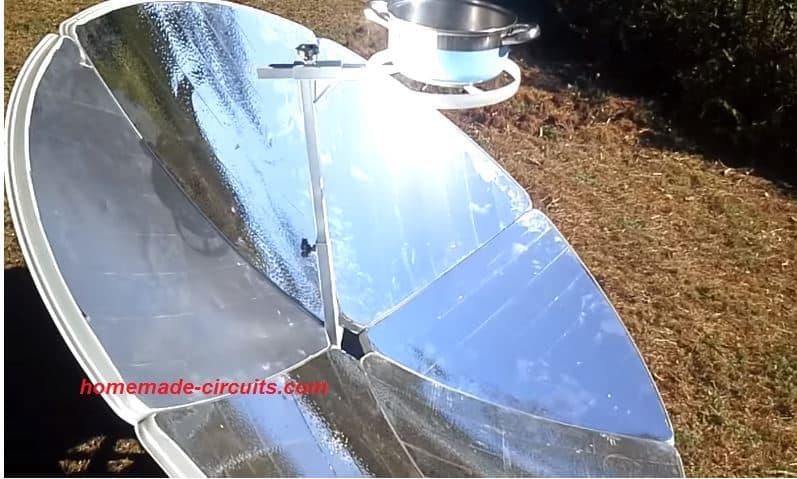If you are fed-up of ordinary inefficient solar cooker designs and wondering how to make a solar cooker that works in a truly effective way, then probably you have reached the right destination.
A low cost solar cooker design that heats up instantly and actually cooks your food in minutes has been meticulously discussed here.
When it comes to making of solar cookers, harnessing solar energy most efficiently becomes one big criteria. The idea presented here is perhaps one of the fastest heating solar cooker designs.
Making a Super Efficient Solar Cooker
You must have read and studied many different solar cooker designs, but do they really work effectively? Precisely speaking most of them work only under cent percent ideal conditions. Moreover, cooking over many of these cookers look pretty impractical and cumbersome.
The main criteria for achieving optimum results with solar heat lies in efficient collection and concentration of sun rays. Solar rays falling straight over a surface may produce just ordinary heating; however collecting them inside an air proof enclosure covered with glass may help enhancing the accumulated heat to more than 50%.
This happens because the usual sun rays which are normally made up of long waves make their way successfully through the glass cover into the box but the reflected rays from the container surface are converted to short waves which by the virtue of their property get trapped inside the box and are unable to escape from the glass cover resulting in the increase in temperature of the enclosed area.
However, acquiring temperatures up to levels that would actually be suitable for cooking purposes looks a big ask as far as getting it from the natural resources is concerned.
Solar cookers made from multilayered boxes with glass covers definitely generate high temperatures inside them, but can never reach temperatures that would cook vegetables or meat optimally.
These cookers are good only for heating water or food that’s already cooked, furthermore as already discussed placing and withdrawing food containers over them doesn’t appear clean enough and may cause a lot of discomfort
The present content will not only answer the question “how to make a solar cooker,” but also a perfect solution to effective cooking using solar power.
Let’s peek into the proposed design and see how it works.
The design produced here is not new and has been exploited over and over again. As discussed in the previous section the main criteria of effective and maximum concentration of the solar rays over a tight spot is the basis of this design.


How to make a simple solar cooker at home:
Referring to the figure, we see that the main component responsible for generating the intense heating effect is the large dish type cone.The cone may be preferably built using an appropriately sized tin sheet.Cut and turn the tin sheet to make a cone of approximately 4 feet in diameter. Make sure that the conical point produces a small hole or opening for the central pole to pass through it. Secure the edge of the cone with nuts and bolts to make a rigid structure.Fix the cone using clamps over a flat open ground as shown at the site where it is to be installed (where plenty of sunshine is accessible.)A hollow metallic pipe is fixed into the ground through the central opening of the cone.
An appropriately sized bowl painted black over its bottom round is fixed through welding at the top end of the pipe as shown in the diagram.This almost completes the simple installation procedure of this super efficient solar cooker system.
As the sun rises, the rays incident over the cone’s inner polished surface gets reflected at a certain angle and get concentrated around the top end of the pole where the welded bowl is positioned.
The pole will need further adjustments until the concentrated rays perfectly strike the bottom of the bowl.You will find that within minutes the bowl gets heated to appreciable limits and sprinkling water over it sizzles.A super efficient solar cooker is at your disposal, any food you desire may be cooked simply by placing it over the central bowl. Now you know all the tricks regarding how to make a solar cooker that truly works.
Post your comments here and get guaranteed replies. Comments must be related to the above article.